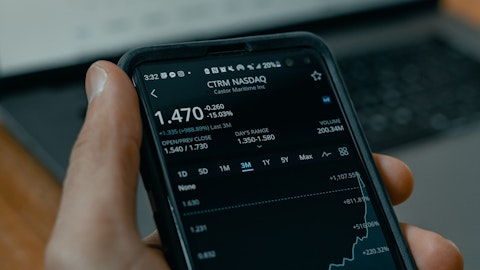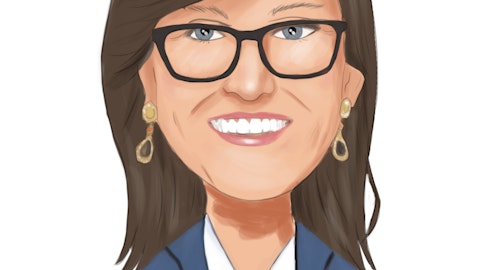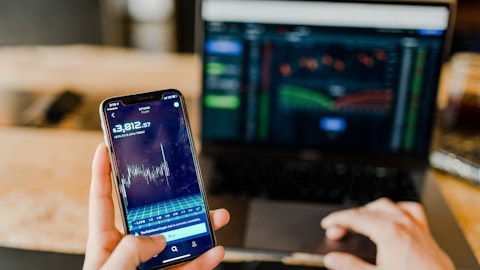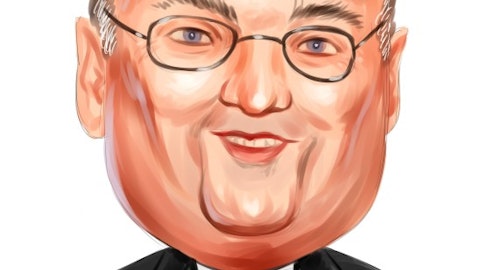4. Thermo Fisher Scientific Inc. (NYSE: TMO)
Number of Hedge Fund Holders: 87
Thermo Fisher Scientific Inc. (NYSE: TMO) is a Waltham-based firm that markets life sciences and specialty diagnostics services. It is placed fourth on our list of 10 healthcare stocks to buy according to Mario Gabelli. 13F filings show that GAMCO Investors owned 42,870 shares in the company at the end of June 2021 worth $21 million, representing 0.18% of the portfolio.
On August 4, investment advisory Credit Suisse assumed coverage of Thermo Fisher Scientific Inc. (NYSE: TMO) stock with an Outperform rating and a price target of $580. Katie Tryhane, an analyst at the advisory, issued the ratings update.
At the end of the second quarter of 2021, 87 hedge funds in the database of Insider Monkey held stakes worth $7.3 billion in Thermo Fisher Scientific Inc. (NYSE: TMO), up from 79 in the preceding quarter worth $6.2 billion.
In its Q2 2021 investor letter, DEVON Equity Management, an asset management firm, highlighted a few stocks and Thermo Fisher Scientific Inc. (NYSE: TMO) was one of them. Here is what the fund said:
“The broad response to the COVID pandemic from the healthcare, pharmaceutical, and life science industries has been nothing short of incredible.
Whilst Vaccine makers understandably garner the highest profile, Thermo Fisher (6.2% of NAV) should be considered one of the outstanding performers, reflected in their ‘COVID related revenue’ hitting US$9.4bn in the 12 months since March 2020 (we appreciate measuring ‘contribution’ to the pandemic by ‘dollars’ generated is a little crude – but ultimately it does tell us something).
Ever the short-termist, Mr Market has looked to the inevitable slowdown in COVID related revenue uneasily – questioning whether it might mean a decline in Earnings come 2022. These concerns resulted in TMO shares declining 5% since their November 2020 peak, the worst performer of our Top 10 holdings.
Fortunately, we look at the COVID dynamic for Thermo in the diametrically opposite fashion.
We think Thermo’s response to COVID has bolstered their competitive positon in multiple verticals, and meaningfully enhanced the long term earnings potential of the company:
Firstly, Thermo came from ‘also-ran’ to leading player in diagnostic testing in 6 months. In ordinary times, this might be expected to take 5+ years. As demand for COVID testing inevitably declines, the capacity Thermo built during 2020 will be filled with demand from non-COVID diagnostic tests, a fast growing area before the pandemic with improved prospects in light of the role testing is playing in the COVID response.
Secondly, Thermo invested heavily throughout 2020 in capacity for the core bioreactor business. Given our constructive view on biologics manufacturing (both volume and value), these investments should translate into sustainably higher market share.
Thirdly, we expect the ~US$4bn of ‘excess’ free cash flow generated from COVID related business to be reinvested into high returning businesses with a more sustainable earnings profile. This is already evident in Thermo’s strong M&A activity YTD, culminating in the US$20bn acquisition of PPD (PPD US).
PPD is a top tier CRO (Contract Research Organisation) which has been in and out of private equity ownership in recent times. To oversimplify, CRO’s effectively provide ‘outsourced’ R&D services across the entire customer spectrum (from big pharma to early stage biotech). Their value proposition varies slightly be customer, but ultimately comes down to quality of drug discovery / development and accelerating time to market (i.e. ‘Return on R&D investment’). CROs must stack up well on this metric vs in-house R&D spend, otherwise Firms would simply keep the spend 100% internal.
In the past Marc Casper (Thermo’s CEO) has been publically sceptical of moving into the CRO market – the simple logic being the creation of an integrated CRO/CDMO6 would bring Thermo into more direct competition with some of their large customers. However the acceleration in R&D spending from big pharma and explosion of innovative R&D activity in well-funded earlier stage Biotechs has driven a boom in the CRO market. COVID and the therapeutic / vaccine responses has added a further leg to the story, and the value proposition of top tier CRO’s has never been stronger.
From a regulatory perspective, one might also point to the relative ease for Thermo to execute a US$20bn CRO acquisition given this is essentially a ‘vertical’ rather than ‘horizontal’ move. Since Thermo are Top 3 in the majority of their segments, any further consolidation of direct competitors in an existing business of comparable size to PPD could prove problematic. Though PPD is ‘vertical’ – we can clearly see synergies with Thermo’s existing businesses, especially in CDMO and clinical trial drug provision / services. The targeted synergies announced in April feel highly conservative, and combined with the obvious potential for accelerated top line performance at PPD once in the Thermo stable, we expect the deal to prove far more accretive on a 3-5 year view than the ~8% earnings accretion based on publicly stated 2022 targets.
Thermo Fisher (and Danaher) have built highly successful multi-brand life science conglomerates, with M&A a critical driver of success. Our confidence in Thermo’s management team to reinvest a large portion of free cash flow into M&A at high rates of return is a key facet of our investment thesis. Done well, inorganic growth can be disproportionately accretive since consensus expectations rarely capture acquisitions as a source of future earnings (even in a demonstrably acquisitive business model such as this).
We established Thermo as a Top 5 position at the Fund’s inception to reflect the company’s strong positioning across a number of attractive life science verticals, with Biopharma and Clinical representing ~70% of end market exposure. We are also attracted to a business model delivering strong and consistent free cash flow generation underpinned by over 50% of revenue derived from consumables.
Given the Fund’s largest position (IQVIA) is a major competitor to PPD, it should come as no surprise we are excited at the prospect of Thermo’s move into the CRO market – in our view one of the most attractive areas of healthcare. Thinking about possible implications for IQVIA, we are not overly concerned about market share loss over the medium term. The CRO market remains fragmented, and we think IQVIA (standalone) and PPD (under Thermo ownership) represent two of the top tier players who are likely to gain market share from second and third tier players.
Thermo Fisher trades on 22x Forward Earnings with a Free Cash Flow Yield in excess of 4%: cheap vs its own history, closest comp Danaher, and the broader life science tools sector. We are comfortable with the possibility of a modest earnings decline in 2022 – to us it would be a reflection of the extent of their successful response to COVID. Recent developments give us increased confidence in the five year earnings and free cash flow prospects for the company. “





